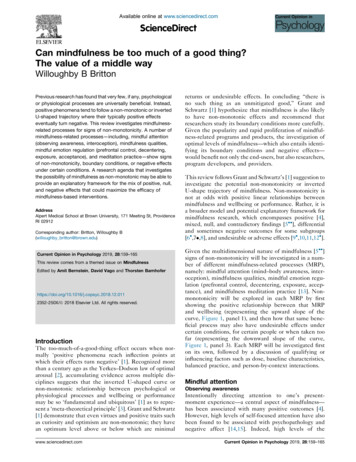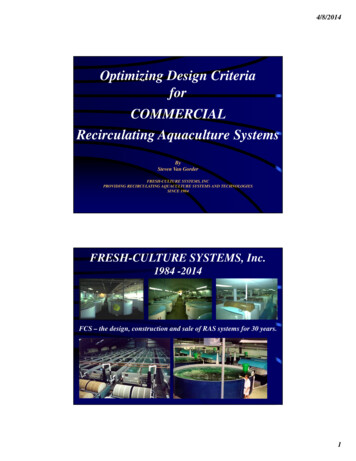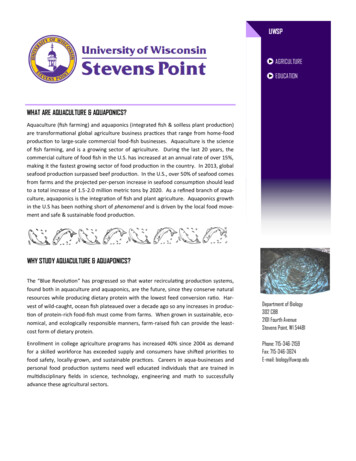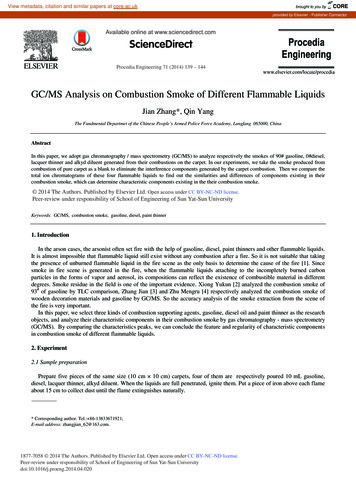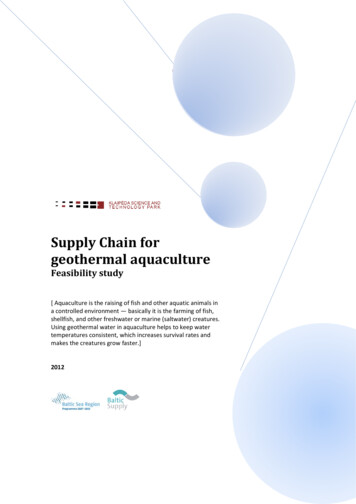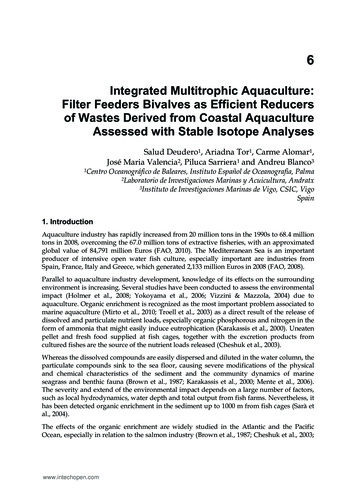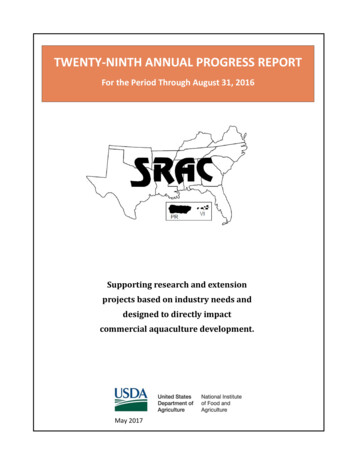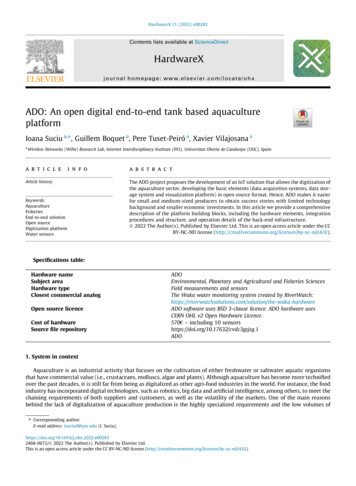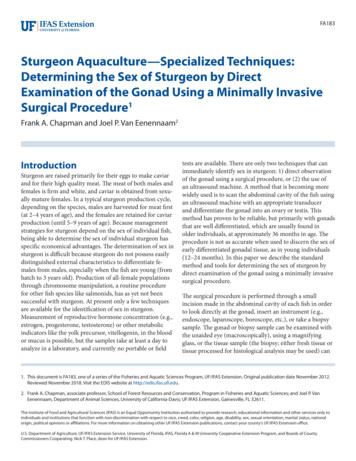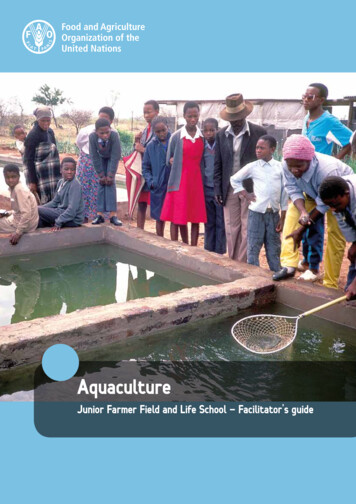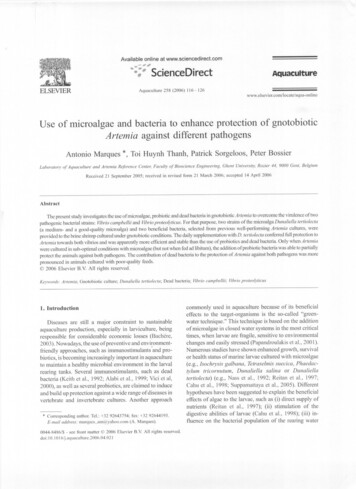
Transcription
Available online at reAquaculture 258 (2006) 116 -126www.elsevier.com/locate/aqua-onlineUse of microalgae and bacteria to enhance protection of gnotobioticArtemia against different pathogensAntonio Marques *, Toi Huynh Thanh, Patrick Sorgeloos, Peter BossierLaboratVl)" of Aquaculture and Artemia Reference Center, Faculty of Bioscience Engineering,Ghent University, Rozier 44. 9000 Gent, BelgiumReceived 21 September 2005; received in revised form 21 March 2006; accepted 14 April 2006AbstractThe present study investigates the use of microalgae, probiotic and dead bacteria in gnotobiotic Artemia to overcome the virulence of twopathogenic bacterial strains: Vibrio campbe11iiand Vibrioproteolyticus. For that purpose, two strains ofthe microalga Dunaliella tertiolecta(a medium- and a good-quality microalga) and two beneficial bacteria, selected from previous well-perfonning Artemia cultures, wereprovided to the brine shrimp cultured under f,'I1otobioticconditions. The daily supplementation with D. tertiolecta conferred full protection toArtemia towards both vibrios and was apparently more efficient and stable than the use of probiotics and dead bacteria. Only when Artemiawere cultured in sub-optimal conditions with microalgae (but not when fed ad libitum), the addition of probiotic bacteria was able to partiallyprotect the animals against both pathogens. The conttibution of dead bacteria to the protection ofArtemia against both pathogens was morepronounced in animals culttlred with poor-quality feeds.iG)2006 Elsevier B. V. All rights reserved.Keywords: Artemia; Gnotobiotic culture; Dunaliella tertiolecta; Dead bacteria; Vibrio campbellii; Vibrio proteolyticus1. IntroductionDiseases are still a major constraint to sustainableaquaculture production, especially in larviculture, beingresponsible for considerable economic losses (Bachere,2003). Nowadays, the use of preventive and environmentIfriendly approaches, such as immunostimulants and probiotics, is becoming increasingly important in aquacultureto maintain a healthy microbial environment in the larvalrearing tanks. Several immunostimulants, such as deadbacteria (Keith et aI., 1992; Alabi et aI., 1999; Vici et aI,2000), as well as several probiotics, are claimed to induceand build up protection against a wide range of diseases invettebrate and invertebrate cultures. Another approach* Corresponding author. Tel.: 32 92643754; fax: 32 92644193.E-mail address:marqucs-am@yahoo.co111(A. Marques).0044-8486/ - see tront matter IQ 2006 Elsevier B.v. All rights reserved.doi: 10.10 16/j.aquaculture.2006.04.021commonly used in aquaculture because of its beneficialeffects to the target-organisms is the so-called "greenwater technique." This technique is based on the additionof microalgae in closed water systems in the most criticaltimes, when larvae are fragile, sensitive to environmentalchanges and easily stressed (Papandroulakis et aI., 2001).Numerous studies have shown enhanced growth, survivalor health status of marine larvae cultured with microalgae(e.g., Isochlysis galbana, Tetraselmis suecica, Phaedactylum tricornutum, Dunatiella satina or Dunaliellatertiolecta) (e.g., Nass et aI., 1992; Reitan et aI., 1997;Cahu et aI., 1998; Suppamattaya et aI., 2005). Differenthypotheses have been suggested to explain the beneficialeffects of algae to the larvae, such as (i) direct supply ofnutrients (Reitan et aI., 1997); (ii) stimulation of thedigestive abilities of larvae (Cahu et aI., 1998); (iii) influence on the bacterial population of the rearing water
A. Marques et al. / Aqllaculture 258 (2006) 1/6-126and thus contributing to the establishment of an early gutmicrobial flora in the larvae (Bergh et aI., 1994; Skjermoand Vadstein, 1999).However, the application of such technologies must bebased on thorough understanding of the mechanismsinvolved and the putative consequences. An essential partof that understanding can be provided by studies looking indetail at host-microbial interactions. A key experimentalstrategy to study these interactions is to first define thefunctioning of the host in the absence of bacteria and then toevaluate the effects of adding a single or defined populationof microbes, or certain compounds (i.e., under axenic orgnotobiotic conditions) (Gordon and Pesti, 1971). Marqueset al. (2004a,b, 2005) have previously shown that the blinesluimp Artemia is instl1lmental in the development of agnotobiotic test system for studying the effect of foodcomposition on survival and growth in the presence orabsence of a challenge test. The test system uses a gnotobiotic Artemia culture in which the microbial community istotally controlled.The brine sluimp Artemia is essential as part of the livefood chain for the culture of fish and shellfish larvae(Sorgeloos et aI., 1986). Artemia can uptake a wide varietyof feed particles (this organism is a continuous and nonselective particle filter feeder able to consume a maximumparticle size of25- 30 /lm for nauplii and 50 /lm for adults),such as baker's yeast and microalgae (Dobbeleir et aI.,1980; Sorgeloos et aI., 1986), which can be cultured axenically (Verschuere et aI., 1999, 2000). Yet, the Artemiafeeding condition has to be taken into account whenculturing this animal in gnotobiotic conditions. In fact,according to Marques et al. (2005), the perfonnance ofArtemia fed with poor-quality feeds can be easily improvedby the addition of non-pathogenic bacteria, partly becausethey are used as a source of nutrients, while the effects ofsuch bacteria are less pronounced in animals fed with betterquality feeds.The present study investigates the use of microalgac,live and dead bacteria in gnotobiotic Artemia to overcomethe vil1llence of two bacterial strains: Vibrio campbellii andVibrio proteolyticus. For that purpose, two strains of themicroalga D. tertiolecta (a medium- and a good-qualitymicroalga), two beneficial bacteria and dead pathogenicbacteria were provided to the brine shrimp.2. Materials and methods2./. Axenic cultures of microalgae and yeastAxenic cultures of two strains of the microalga D.tertiolecta (strains DT CCAP 19/6B and DT CCAP 19/27, hereafter called DT-med and DT-opt)were obtained117from the Culture Collection of Algae and Protozoa Department (CCAP, Dunstaffnage Marine Laboratory,Scotland). Each strain was cultured according to theprocedures developed by Marques et al. (2004b), using10% inocula, 0.22-J.lm filtered aeration, continuous light,a standard Walne medium (Walne, 1967) and filtered andautoclaved sea water (FASW, 0.2 J.lm).Algal strains wereharvested by centrifugation in the exponential growthphase. All handlings were perfonned in a laminar-flowhood to maintain axenity.The wild-type strain (WT) of the baker's yeastSaccharomyces cerevisiae (BY4741, genotype Mat a;his3/l/; leu2/l0; met/5/l0; ura3/l0) was provided bythe European S. cerevisiae Archive for FunctionalAnalysis (EUROSCARF, University of Frankfurt, Germany). The procedures used to culture this yeast wereidentical to the methods described by Marques et al.(2004a,b; 2005). Yeast cultures were grown in sterileErlenmeyer flasks with a cotton cap placed on a shaker inthe dark (30 C, ISO rpm). A complete yeast extractpeptone-dextrose medium was used to culture the yeast,containing yeast extract (1%, wt/vol; Sigma), bacteriological-grade peptone (1%, wt/vol; Sigma), and 0glucose (2%, wt/vol; Sigma). The medium was preparedin FASW sterilized by autoclaving at 120 C for 20 min.The yeast was harvested by centrifugation in the stationary growth phase. All handlings were performed in alaminar-flow hood to maintain axenity.Yeast and microalgal cells were resuspended in FASWand their densities were determined by measuring twicethe cell concentration, using a Burker haemocytometer.Suspensions were stored at 4 C and used to feed Artemiauntil the end of each experiment. The three feed sourceswere chosen according to their nutritional quality toArtemia: poor-quality feed (WT yeast-enabling lowArtemia survival and low growth), medium-quality feed(microalga DT-med-enabling intermediate values ofArtemia survivals and growth) and good-quality feed(the micro alga DT-opt-enabling high Artemia survivaland growth) (Marques et aI., 2004a,b, 2005).2.2. Bacterial strains and growth conditionsTwo bacterial strains (strain LVS 2-Bacillus spp.; andstrain LVS 3-Aeromonas hydrophila, both strains wereisolated from Artemia cultures performed in the Laboratory of Microbial Ecology and Technolob'Y, Ghent University, Belgium, by Lament Verschuere in 1999) wereselected for their positive effect towards Artemia(Verschuere et aI., 1999, 2000; Marques et aI., 2005)and examined for their ability to protect nauplii cultured indifferent gnotobiotic environments against two different
118A. Marques et al. / Aquacullure 258 (2006) 116-126pathogens, namely, V.proteolyticu.s strain CW8T2 (VP),isolated from artificial feed from a sea bass hatchery inSpain (Verschuere et aI., 1999, 2000; Marques et aI.,2005), and V.campbellii strain LMG21363 (VC), isolatedfrom the lymphoid organ of a diseased juvenile Penaeusmonodon in Negros Island, Philippines, by C. LavillaPitogo in 2002 (Soto-Rodriguez et aI., 2003; Gomez-Gi]et aI., 2004; Marques et aI., 2005). Pure cultures of thefour bacteria] strains were obtained from the LaboratOlYof Microbia] Eco]ogy and Techno]ogy, Ghent University,Belgium, and from the LaboratOlY of Microbiology,Ghent University, Belgium. All bacterial strains werestored at - 80 C and were cultured on marine agar (MA),according to the procedures described by Marques et al.(2005). Bacteria were harvested by centrifugation, thesupernatant was discarded and the pellet was resuspendedin FASW. Bactelial densities were detClmined by spectrophotometry (OD550 1.000 corresponds to 1.2 xl 09 cells/ml; according to the McFarland standard, BioMerieux,Marcy L 'Etoile, France, and confirmed in our study for allbacterial strains). Dead bacteria were offered to Artemiausing aliquots of autoclaved concentrated bacteria (autoclaving at 120 C for 20 min). In order to check if thebacteria were effectively killed by autoclaving, the strainswere plated after being exposed to this method. For thispurpose, 100 [.t.1of the culture medium were transferred tomarine agar (MA; n 3). Absence of bacterial growth wasmonitored after incubating plates for 5 days at 28 C.Autoclaving treatment was 100% effective, since nobacterial growth was observed on the MA after 5 days ofincubation. Dead and live bacterial suspensions werestored at 4 C until the end of each experiment.2.3. Artemia gnotobiotic cultureExperiments were performed with Artemia franciscana cysts, originating from Great Salt Lake, Utah, USA(EGB!Type, INVE Aquaculture NV, Belgium). Bacteriafree cysts and nauplii were obtained via decapsulationaccording to the procedures described by Marques et al.(2004a,b). During decapsulation, 0.22 /lm filtered aeration was provided. All manipulations were calTied outunder a laminar flow hood and the tools were previouslyautoclaved at 120 C for 20 min. Decapsu]ated cystswere washed carefully with FASW over a 50-[.t.mporesize sterile net and transferred to a sterile 50 ml screw capFalcon tube (TRP@, "{-irradiated) containing 30 ml ofFASW. The tube was capped and placed on a rotator at4 cycles per min, exposed to constant incandescent light(::1:41IlEm-2) at 28 C for ]8-20 h. Twenty axenicnaup]ii (Instar U) were picked and transferred to sterile50-ml containing 30 ml of FASW, together with theamount of feed scheduled for day I. In treatments wherebacteria were used, the bacterial suspension was added ata density of approximately 5 x ]06 cells/ml. Each treatment consisted offour tubes (replicates). The tubes wereplaced on a rotator at 4 cycles/min, exposed to constantincandescent light (::1::41 !Em -2) at 28 C, being transferred to the laminar flow just once per day for feeding.The daily feeding schedule was adapted from Marques etal. (2004b) and was intended to provide ad libitum ratios,avoiding excessive feeding not to affect the water qualityin the test tubes. The total Ash Free Dry Weight (AFDW)of microalgae, yeast and bacteria added to Artemia inexperiments 1-3 was calculated following the procedures described by Marques et al. (2004a,b).2.4. Methods used to verifY axenityAxenity of feed, decapsulated cysts and Artemiacultures were checked at the end of the experimentsusing a combination of plating on MA (n 2) and livecounting (staining each sample with tetrazolium saltMTT( -3-( 4,5-dimethylthazol-2-yl)- 2,5-diphenyl tetrazolium bromide», following the procedures of Marqueset al. (2004a,b, 2005). Contaminated culture tubes werenot considered for further analysis and the experimentwas repeated. Plating and live counting were also used todetect contaminations in treatments where live bacteriawere supplied to Artemia. Therefore, pure cultures ofthebacterial strains, as well as the samples of Artemia cultures, were stained with MTT and plated on marine agar.The shape and coloration of the bacterial colonies present in the Artemia cultures were visually compared tothe characteristics of the pure bacterial cultures. Whenever different shaped or coloured colonies were found inthe samples, the results of Artemia performance wererejected and the experiment was repeated.2.5. Experimental designThis study comprises three experiments (see Fig. 1). InExperiment 1, selected bacteria (LVS 2, LVS 3 or a mixture ofLVS 2 and LVS 3 added in equal proportions, calledMIX) were tested on Artemia fed with the medium-qualitymicroalga DT-med [sub-optimally fed-exp lA, or fed adlibitum-exp lE (AFDW of2260.32::!::66.70 Ilg/FT AFDW,n 2)] and challenged with the pathogens VC or VP. Immediately after feeding Artemia for the first time, an LVS(or the MIX) strain was provided only once at a concentration of 5 x ]06 cells/m I (colTesponding to an AFDW of45.87::1::3.87[.t.g/FTfor LVS 2, 35.17::1::I.531lg/FT for LVS3, and 40.5H2.7][.t.g/FT for MIX; n 2). Forty-eighthours later (day 3), Artemia cultures were experimentally
119A. Marques et al. / Aquaculture 258 (2006) /16-126Day 1startDay2b) MB---c) Ad) MB--ExpIA-2Aa) AExp18-28 e) Af) A Bg) Ah) MBExp i) F3--------j) F DP--k) F DP-I) F-m) F DP---n) F DPDay4Day3Day5Day6harvestAA--A -A -A -A -F -F -F DP-F -F -AAF DP--PPA -A -A P-A P-F -F---F DPF P-F P--------F DP-F -F -AAAAFFF DP P-F DP--AAAAFF.F DPFF.F DPFig. I. Experimental design of the three experiments (Exp) performed. Legend: Exp 1A-2A-the feed was added only at day 1 and day 2; Exp 1B-2Bthe feed was added daily from day I until day 5; (a-n) correspond to the treatments performed; A--algae (the strains DT-med or DT-opt); B-beneficialbacterium (LVS 2, LVS 3 or a mixture of equal amounts ofLVS 2 and LVS 3-MIX); P Live pathogen cv. campbellii or V.proteolyticus); F-feedprovided in Exp 3: the WTyeast and the micro alga DT-med; DP-Dead (autoclaved) pathogen (V. campbe/lii or V.proteo(vticus).infected with the same concentration of VC or VP(corresponding to an AFDW of 37.98*0.14 }.lg/FT forVC, and 36.02* 0.54 flg/FT for VP; n 2). As controltrcatments, Artemia were only supplied with the microalgawithout any bacteria; or supplied with the microalga andinoculated with VC or VP at day 3; or fed with themicroalga and inoculated with an LVS strain at day I (seeFig. I). In Experiment 2, an identical procedure toExperiment I was applied, changing only the feed suppliedto Artemia: the good-qualitymicroalga DT-opt(con-esponding to an AFDW of 2710.57* 53.99 tg/FTwhen supplied ad libitum; n 2). In Experiment 3, dead VCor dead VP were offered to Artemia [at day I (corresponding to an AFDW of33.56*0.56 flg/FT for VC, and31.9\::1::3.04 flg/FT for VP; n 2), or daily until day 6(cOlTesponding to an AFDW of 167.79* 2.81flg/FT forVC, and 159.55* 15.22 flg/FT for VP; n 2)] fed with thepoor-quality WT yeast (corresponding to an AFDW of1057.95*84.76 flg/FT; n 2) or with the medium-qualitymicroalga DT-med, and challenged at day 3 with the samelive pathogen (similar AFDW as provided in Experiments Iand 2). As control treatments, Artemia were maintainedonly with the feed; or maintained with the feed and infectedwith live VC or VP at day 3; or daily fed and supplied withdead pathogens at day I or daily (see Fig. I). The experiments were performed twice to verifY the reproducibilityof the results. In addition, Artemia perfonnance of thecontrol treatments was compared to results previously ob-tained by Marques et aI. (2004a,b, 2005). If significantdifferences were detected, data were not considered forfurther analysis ,md the experiment was repeated.2.6. Survival and growth ofArtemiaThe survival percentage was determined daily foreach treatment. In this way, the number of live Artemiawas registered before feeding or adding any bacteria, byexposing each transparent Falcon tube to an incandescent light without opening the tube to avoidcontamination. At the end of each experiment (day 6after hatching), live Artemia were fixed with Lugol'ssolution to measure their individual length (IL), using adissecting microscope equipped with a drawing min-or, adigital plan measure and the software Artemia I.O@(courtesy Mm'nix Van Damme). As a criterion thatcombines both the effects of survival and IL, the totalviable length (TVL) (expressed in millimetres per Falcontube-mm/FT) was detennined according to the following equation: TVL number of survivors x mean IL.2.7. StatisticsThe percentages of\arval survival were arcsine u-ansfonned, while values ofIL and TVL were logmithmic orsquare root transfonned, whenever required to satisfYnormal distribution and homocedasticity requirements.
120A. Marques et al. / Aquaculture 258 (2()(}6) J16 126Table IExperiment I-Dailysurvival (%), individual length (lL) (mm) and total viable length (TVL) (mm per Falcon tube-FT)of Artelllia fed with themedium-quality microalga DT-med only until day 2 (Exp lA) or from day I to day 5 (Exp IB), inoculated with LVS 2 or LVS 3 at day ITTreatmentsSurvival (%)Day 2IL(mm)TVL 0ieS.34c9.20ie4.20"'c6.S8ie3.40 9.31 ie6.7t.c4. 73 4.66cIS.06ie6.92"b.cDay 3Day 4Day 5Day 6Exp lA-Feedingonly until day 2aDT-med8SieIO"bDT-med LVS289ie8"bDT-med LVS3SI ie I'cDT-med VC87 ie9"DT-med LVS2 VCd86ie9"dDT-med LVS3 VC8al"cDT-med VP81H'84ie I"dDT-med LVS2 VPdDT-med LVS3 VP81'" I'70ie 19".b79 ie 7"71 ie3"74ie 18".073 ie IS".b61 ie3b7H 18".069 ie 3".061 "'3'6H18"SHI8"4S ie 13".b63ie 17"6(HI6"46 ie lO".b4IieI4,.b49 ie 19"'0.c31 ie 3c14ie9 140 ie 14,.b, 31 ie t.c.d38'" lO".b.c48ie 19"44ie8"39ie 1O'IH13 20ie 9"IH6b2aIS"'0I1 ie lib31'" 14,.b2.IOieO.S4"2.81 ie 1.18"2.14ieO.60"2.12ieO.26"2.30ieO.S4"2.63 ie O.SS"Exp I B-FeedingfimnDay I to 584"'9'eDT-medfDT-med LVS289:!:8"78'" 12'fDT-med LVS3DT-med VC78:1:3'ghDT-med LVS2 VC88'" 12'hDT-med LVS3 VC83'" 3"80 7"DT-med VPghDT-med LVS2 VP84'" 13'h78 '" 10'DT-med LVS3 VP76'" 14,.b898'76 13,.068'" 16,.b69'" lOb70"'7b76:1: lO".b73:1:17"b74'" 13".b60:l:21,.b.c8HI2"76'" 13'36'" 17h,c30'" 12c49"'3h63 '" 13'.06621"b64'" 11"SS:l:21,.b.c79:1:9'7S'" 14"29:1:19b.c23'" 16 40 110.c6014o,b64:1:21,.b63:1:12"I.SaO.43'SS ie 17"2S ie 7bSOieI4'49ie9"41"'13'.b64:1: 14,.b. 8HI2"76'" 13'40 ie ISb.c.d36'" 12 1SOHf63 :I: 13,.b.c71:1:18".b70'" 13"2.19ieO.58"2.1 00.44"2.41 .21 ieO.42"1.89 0.40'2.01 :1:0.61'2.0 I :I:0.45"19.91 "'7.68,.b.c29.14"'3.16'30.7HS.SS"11.04'" 7.2Sc10.40'" 7.18c17.68ie4.77b.c22.68 :I:S.12"b.c2S.63 :l:8.43,.b,c2S.13:1:4.78"0VC- V.call1pbellii, VP- V.proteo l'ticus, T-Treatment, a-h correspond to the treatments perfonned. Data provided are the means with the standarddeviation (mean S.D.). The first column in the table is the treatment type of Fig. I. Values in the same column showing the same superscript lettersare not significantly different (PTllkcy O.OS).Differences in survival, IL and TVL of Artemia culturedin different conditions were investigated with t-test,analysis of variances (ANOVA) and Tukey's multiplecomparisons range. All statistical analyses were tested at0.05 level of probability, using the software Statistica5,5@ (Statsoft, Inc),3. Resultsparison to unchallenged nauplii (trcatment a), althoughonly significantly with vc. The supplementation of selected bacteria to challenged Artemia fed with the microalga DT-med (treatments d and h) never improvedArtemia performance significantly. No additional improvements in Artemia performance were observed whennauplii were supplied with MIX in comparison to the useof a single beneficial bacterial strain (results not shown).3.1. Artemia fed with the medium-quality microalga3.2. Artemia fed with good-quality microalgaAccording to Table I (Experiment 1), the performanceof Artemia fed only until day 2 with the medium-qualitymicroalga DT-med (treatment a) was not significantlydifferent than nauplii fed daily with the same microalga(treatment e) (11 4;p 0.997), The addition of selectedbacteria did not improve TVL of Artemia fed with thismicroalga (treatments band t) in comparison to the bacteria-free control (treatments a and e), Artemia challengedwith VC or VP and not supplied with the selected bacteria(treatments g) performed as good as unchallengedArtemia (treatment e), when fed daily with the microalga, Yet,Artemia cultured under starvation conditions with thisArtemia fcd with the good-quality micro alga DT-opt(Table 2-Experiment 2) presentcd significantly lowerTVL when fed only until day 2 (treatment a) in comparison to nauplii fed daily (treatment e) (n 4;p 0.OO2).When fed sub-optimally with DT-opt in the presence ofselected bacteria (treatments b), Artemia performancepresented no significant improvements in comparison tothe bacteria-free control (treatment a). Yet, significantimprovements in TVL were found with nauplii fed dailywith this microalga and supplied with LVS 2 or LVS 3(trcatments t), mostly due to higher IL. Artemia fed onlyuntil day 2 witl1 DT-opt, challenged with VC or VP andnot supplied witl1 tI1e selected bacteria (treatments c)generally revealed lower TVL in comparison to themicro alga and challenged with both pathogens (treatments c) presented generally lower performance in com-
121A. Marques et at. I Aquaculture 258 (2006) 116--/26Table 2Experiment 2-Dailysurvival (%), individual length (IL) (mm) and total viable length (TVL) (mm per Falcon tube-FT) of Artemia fed with thegood-quality microalga DT-opt only until day 2 (Exp 2A) or from day I to day S (Exp 2B), inoculated with LVS 2 or LVS 3 at day ITTreatmentsSurvival (%)Day 2Exp 2A-Feeding only until day 2a97 ci2'DT-opt96ci3'bDT-opt LVS2b9S ci4 aDT-opt LVS398 ci 2'cDT-opt VCd9Sci2'DT-opt LVS2 VCd9Sci4aDT-opt LVS3 VCc94ci3aDT-opt VPd96ci3aDT-opt LVS2 VPd83 ci4 bDT-opt LVS3 VPErp 2B-Feedingfi'01l1 Day 1 10 5e93 ci6aDT-opt96ciSafDT-opt LVS29Sci4afDT-opt LVS391ci9agDT-opt VCh93ci6aDT-opt LVS2 VCh94ci3'DT-opt LVS3 VC98ci4agDT-opt VPh98 ci4 uDT-opt LVS2 VPh98ci2aDT-opt LVS3 VPIL (mm)TVL (mm/FT)Day 3Day 4Day SDay 694 ci S"91 ci6,.b90ci8a,b9Sci4a84ci 11'84ci 8'81ci3'86ciSa90ci4a.b90ci 8,.b88 ci6a,b93 ci 6a,b81 ci7b79ciSa73cil3a79ci 14a88ci9'44ci6b66 ci IS,.b74ci 14a64 ci Sa39cilOc43 ci 10b.cSicilYSlcil3'29 ci I 7a,b,c3 ci S"lOci 8c",ISci7b,c3ci3"13ci 7 .33a,b2.2HO.4Sb22.14ciS.40a.b24.29ci6.23'14.38ci 8.26a,b,c1.34ci2.67"S.IH4.18c."8.13ci3.83cI.SOci 1.73"6.60ci4.S7c."13.0Sci3.88b.c93 ci 6a.b.c96ciS"b94ciSa,b,c8S ci7b.c91 ci Sa,b,c90c9S ci 7a,h,c9S ci 7,.b.o96ciSa.b91 ciSa,b.c96ci Sa,b90ci4"96ciSa9lciSa73 ci IOb.c63 ci 9c71 ci8b,c95 ci 7'88ci 16a.b89ci II a.b2.08 ci O.40b,c2.13 ci 0.39c3.07 ciO.64'.b3.70ciO.69a3.61 ciO.62a37.44ci 1.70c42.7H2.13b43.44ci2.28b33.21 ci4.39c."28.1H3.90"30.0H3.59"58.3H4.34aM.7Sci 11.50"64.08ci8.00'49 ci 14 a.b,c4Sci Ilb.c49ci8b,c41 ci9c81 ci9c84ci 8b,c86ciSb,c9S ci 7a,b,c91 ci9u,b,c9lciSa.b96ciS'93 ci3 a74ci llc78 ci IOb.c81 ci3c9S ci 7a91ci9a.b.c94 ci Sa.b,c89 ci I1 a.b,c94 ci Sa,b,cVC- V. camp/Jellii, VP- V.pmteolylicus; T-Treatment; a-h correspond to the treatments performed. Data provided are the means with the standarddeviation (meanciS.D.). The first column in the table is the treatment type of Fig. I. Values in the same column showing the same superscript lettersare not significantly difterent (PTukcy 0.05).pathogen-free control (treatment a). Yet with DT-opt fedad libitum to Artemia, bacteria-free nauplii (treatment e)showed no significant differences in TVL in comparisonto nauplii challenged with VC (treatment g), while nauplii challenged with VP even increased significantlyTVL (treatment g), due to higher IL. Generally, theinoculation of selected bacteria to challenged nauplii feddaily with DT-opt (treatments h), could not significantlyalter their TVL in comparison to treatments where onlypathogens were provided (treatments g). Yet, Artemiafed sub-optimally with DT-opt, challenged with VC orVP and supplied with the selected bacteria (treatments h) generally revealed higher TVL in comparisonto treatments where only pathogens were provided(treatments c), although only signiticantly with LVS 3(treatments d), mostly due to improvements in survival).No additional improvements in Artemia performancewere observed when nauplii were supplied with MIX incomparison to the use of a single beneficial bacterialstrain (results not shown).3.3. Artemia fed with dead pathogensPerformance of Artemia (challenged or not with livepathogens) fed with a major feed source (WTyeast or themicroalga DT-med) and with dead VC or VP is presentedin Table 3 (Experiment 3). Nauplii fed with both themajor feed sources and with dead VC or VP at day 1(treatments j) or daily (treatments k) presented generallysigniticantly higher Artemia TVL in comparison to nauplii fed solely with the major feed source (treatments i),due both to improvements in survival and IL. However,this improvement was less pronounced with the mieroalga DT-med than with the WT yeast. In terms of AFDW,the highest ratio obtained between amounts of deadpathogens and amounts of the major feed source provided to Artemia was relatively Iow (0.012-0.031 whenthe dead pathogens were added solely at day 1, and0.056-0.137 when added daily until day 5). Artemia fedwith WT yeast and challenged with VP (treatment I)could survive until day 6, revealing no significant differences in TVL in comparison to the bacteria-free control (treatment i), while all nauplii fed with the sameyeast and chaIJenged with VC died before day 5 (treatment I). The addition of dead VC orVP at day I (or daily)to Artemia challenged with the same pathogens (treatments m and n) generally induced a higher TVL at theend of the experiment in comparison to challenged nauplii not supplied with dead bacteria. Yet, significantlyhigher survival was only registered at day 4 (in the 4
-----122A. Marques el af. / Aquaculwre258 (2006) 116-126Table 3Experiment 3-Mean daily survival (%), individual length (IL) (mm) and total viable length (TVL) (mm per Falcon tube-FT) of Arlemia fed withwild-type yeast (WT) cultured in YEPD or with the microalga D. tertiolecta (DT-med strain)TExperiment 3jkImnWTWT deadWT deadWT liveWT deadWT deadjkImnijkImnjkImnIL (mm)Survival (%)TVL (n1fn/FT)Day 2Day 3Day 4Day 5Day 6572e83 5b90:l7"b58:l5c78:l4b81 :l3b485cG5 llc,d90:l7,.b45:l I I".55:l7""81 :l3b23 GCGO 15c.cl83d40 :l OC88 :lG'OfOf5 :l6d,c,fI.GI 0.16b1.71 0.34a.b2.19:l0.38'WT dead VP DIWT dead VPWT live VP D3WT dead VP DI live VP D3WT dead VP live VP D3DT-IlledDT-Illed dead VC DIDT-med dead VCDT-med live VC D3DT-med dead VC D I live VC D3DT-Illed dead VC live VC D388:l4,.b866"b5S:l2c89 :l4,.b96:lI'925'93 3'G4 14b70:l8,.b21:lSc70:l8b8S :l3'84:lIO"b84 :l5,.b933'SO:lSb94 :lS,.b76:llOb549S3"904'97:l4"89 :l4a7G9b.c849"h,c46:l5"79:l9b,c93 :l3'84 :lIO"b85 Hi"b95 4"SO:lSb94:l8'.b7S:l9b5 :l4c34:l5"6S 12b83 1O"b84 :l5".b904'79 le.1O",b88:l1 Oa.h71 :l9b39 :l5c56 :l7bI 3cf5 4"'c34:lllc75 15b.c75 .99:l0.40",b1.7]b1.59:l0.32bI.S7 :l0.34",b2.21 l0.40'13.56 3.156.5Ib,c32.40:l4.67b.c38.36X 2.24b27.16X6.36c33.04 8.65h,c32.33:l5.03b,cDT-Illed dead VP DIDT-med dead VPDT-med live VP D3DT-med dead VP DI Iive VP D3DT-med dead VP live VP D3S9 7'963'943a89 :l6a91 2a78 14"b9S:l4'89 :l6,.b79 :l13a,bSI S"7G:l15,.b95 :l4a89 :lG,.b78 14"h807b75 17".b94 :lSa86 11",b75 :l17a."78 :l5b71 :l21 a.b,c93 :l3a808h,c74:l19a.b,c70:l4c2.23:l 0.45"2.820.6Ia2.27 36.323.7Ib,c34.81 :l8.91 b.c37.80:l2.20"VC DIVCVC D3VC DI Iive VC D3VC live VC 2.83'0.00'0.00'1.55 :l1.79"'cNauplii were inoculated with dead V. campbe/lii (VC) or V.proleolylicus (VP) added only at day I (D I) or daily and challenged with the same livepathogen added only at day 3 (D3). T -Treatment, i-n correspond to the treatments performed. The first column in the table is the treatment type ofFig.!. Means were put together with the standard deviation (meanS.D.).Values in the same column showing the same superscript letter are notsignificantly different (PTukcy 0.05).treatments where dead pathogens were added) and day 5(3 out of 4 treatments), Artemia fed with the microalgaDT-med and challenged with both pathogens (treatmentsI) suffered no significant reduction in TVL in comparison to the pathogen-free control (treatment i), Theaddition of dead bacteria (at day I or daily) to Artemiafed with the microalga and challenged with bothpathogens (treatments m and n) did not enhancesignificantly the animal pelformance in comparison totreatments where only live pathogens were provided(treatments I).
under a laminar flow hood and the tools were previously autoclaved at 120 C for 20 min. Decapsu]ated cysts were washed carefully with FASW over a 50-[.t.m pore size sterile net and transferred to a sterile 50 ml screw cap Falcon tube (TRP@, "{-irradiated) containing 30 ml of FASW. The tube was capped and placed on arotator at
